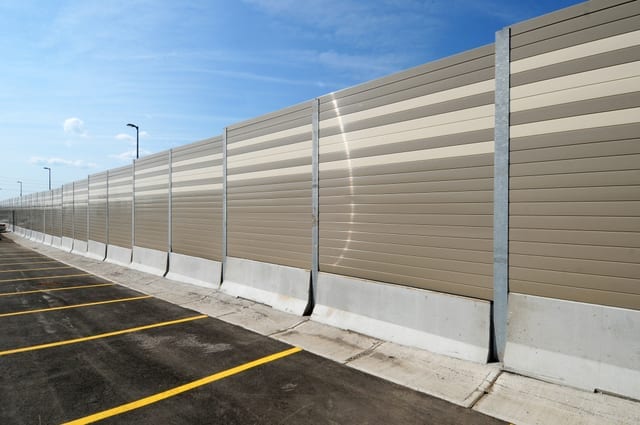In the battle against noise pollution, traditional noise barriers — think concrete walls and acrylic panels — have long been the go-to solution. But now, a new contender has entered the chat: noise barrier sheets.
Flexible, modular, and often marketed as cost-effective and easy to install, noise barrier sheets are popping up at construction sites, industrial zones, and even around residential properties. But here’s the million-dollar question: Are these sheets a true replacement for traditional noise barriers, or are we just caught up in the latest industry trend?
What Are Noise Barrier Sheets, Really?
Noise barrier sheets are typically flexible, sound-dampening materials made from a combination of vinyl, mineral wool, fibreglass, or composite layers. Many come in roll or curtain form, and they’re designed to absorb and block sound in temporary or semi-permanent settings.
You’ve likely seen them draped around construction scaffolding or wrapped along fences near roadworks. They’re lighter and easier to handle than solid panels, which makes them particularly attractive for short-term or mobile use.
The Benefits: Where They Shine
Let’s give credit where it’s due. Noise barrier sheets bring some real advantages to the table, especially in urban environments like Singapore or London, where space and time are always tight.
1. Flexibility and Portability
Unlike concrete walls, noise reduction sheets can be installed, removed, and reinstalled without heavy machinery or weeks of prep. For construction companies that hop from project to project, this is a game-changer.
2. Cost-Efficiency
While pricing varies depending on quality, most noise barrier sheets are cheaper to manufacture, transport, and install than traditional materials. That makes them an appealing choice for budget-conscious developers or municipal planners needing temporary solutions.
3. Quick Installation
These sheets can often be set up in a matter of hours. That’s ideal in situations where delays are expensive or when emergency noise protection is needed.
4. Versatility
You can wrap them around poles, hang them on fences, or mount them to scaffolding. They also tend to be fire-retardant, waterproof, and UV-resistant, making them suitable for Singapore’s weather.
But Let’s Be Real — They’re Not Perfect
While barrier sheets serve a clear purpose, they’re not a miracle cure. The most obvious issue? They don’t provide the same long-term performance as solid barriers.
1. Lower Noise Reduction Ratings
Sheets typically offer 5–15 dB of noise reduction, depending on material and installation. That’s helpful, but not nearly as effective as a well-designed concrete or acrylic wall, which can block 20–30 dB or more.
2. Limited Use Cases
They work great for construction zones, event setups, or short-term industrial projects. But in residential areas, especially near highways or train tracks, they’re not going to hold up, literally or acoustically, as a permanent fix.
3. Durability Issues
Even with weatherproof coatings, sheets can degrade over time. Prolonged exposure to sunlight, rain, or heavy winds may lead to fraying, sagging, or a drop in performance. Not ideal for year-round use.
4. Aesthetic Trade-Offs
Let’s be honest, even premium noise barrier sheets often look temporary. For upscale neighbourhoods or locations with architectural restrictions, they may not meet visual expectations.
Are They Replacing Traditional Barriers? Not Quite.
It’s tempting to think we’ve found a cheaper, faster fix to urban noise. But noise barrier sheets aren’t replacing traditional barriers, they’re complementing them.
Think of them as the acoustic equivalent of a pop-up tent: incredibly useful when speed and mobility matter, but not what you’d want in your backyard for the next 10 years.
Governments and developers increasingly use them during early construction phases to protect nearby residents from day-to-day construction noise. But once permanent structures go up, they’re usually removed or replaced with long-term solutions like concrete or composite barriers.
In Singapore, for example, noise barrier sheets are often seen along MRT expansion works or road repairs. But permanent noise control solutions — like full-height steel or acrylic walls — are used along expressways and residential-facing lines.
Are They Just a Fad?
No, but they’re also not a silver bullet.
Noise barrier sheets are gaining popularity because they fill a critical gap: short-term, flexible, mobile noise control. In that niche, they’re not just a trend — they’re a practical solution. More manufacturers are now offering high-performance variants with multi-layered insulation, improved fire ratings, and even custom branding for commercial projects.
But for large-scale, long-term noise problems like highway traffic, airport runways, or dense condo clusters, traditional barriers still dominate for a reason. They offer consistent, structurally sound protection, not to mention better resale value for nearby properties.
The Smart Approach: Hybrid Noise Management
So, what’s the best move for city planners, developers, and homeowners?
Use both.
Deploy noise barrier sheets in the early stages of construction, maintenance, or event planning. But don’t rely on them as the final answer. Combine them with:
- Green noise buffers (trees, berms)
- Sound-absorbing building materials
- Smart urban design (setbacks, orientation)
- Permanent structural barriers where appropriate
When integrated well, sheets can serve as part of a broader noise mitigation strategy — one that’s flexible enough for urban life but sturdy enough to last.
Final Verdict
Are noise barrier sheets replacing traditional barriers?
No, but they are redefining what effective, adaptive noise control looks like in the modern world.
They’re not a passing fad. They’re here to stay, but not as a standalone solution.
If we treat them as what they are, a smart, tactical tool in the wider acoustic arsenal, they’ll keep proving their value project after project.


